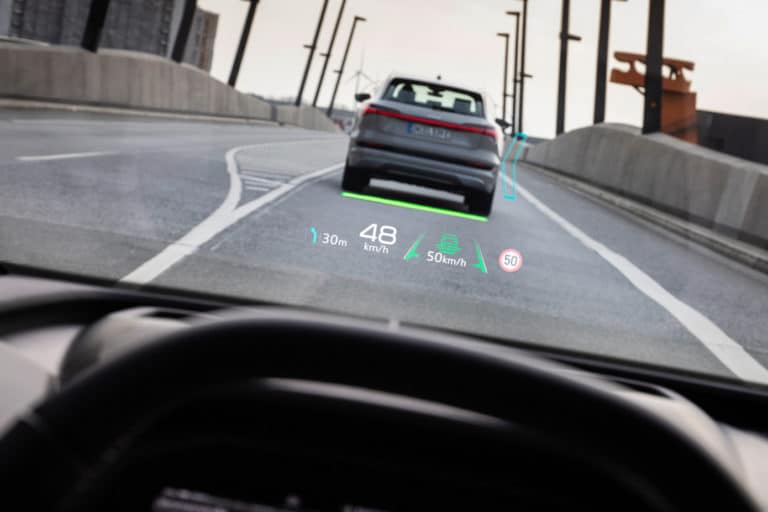
AR hit the mainstream through gaming. Pokémon GO allowed users to take pictures of and with virtual creatures as though they were in the real world. The idea of projecting virtual objects onto real-world surroundings isn’t a new one, but the technology has finally caught up with our imaginations and is bursting into all sorts of industries.
Let’s take a closer look at seven different uses for AR that you probably didn’t even know about.
1. Driving
Looking through an AR headset on your daily commute might seem like a dangerous choice, but the technology is already showing up in new cars in the form of a heads-up display (HUD).
These displays project important information — speed, fuel or battery levels, navigation, and other data — and lift it up from the dash and into the driver’s view. They keep you from having to look down at your dashboard but don’t obscure your view of the road. If you’re driving an older model, there are plenty of aftermarket automotive AR HUDs that you can install in nearly any car.
2. Medical Training
Hands-on medical training is an essential part of medical school and residency. But for difficult or delicate procedures, you don’t generally want to let unskilled hands do the work. AR headsets give medical students and residents the ability to practice challenging procedures without putting a patient at risk.
While it’s no replacement for hands-on experience, it can help lay a foundation the students can later build on.
3. Retail Shopping
Retail has become the latest AR battleground, as companies compete to come up with the newest application that will set them apart from the competition.
For example, Amazon lets you use your phone’s camera to see what furniture and other items might look like in your space before you click that Buy Now button. Renovation company Houzz uses it in a similar way, allowing people to see what their renovation might look like before it starts. Houzz reports that those who use the AR tools spend up to 2.7 times more on the app than those who don’t, and that AR increases the likelihood of purchasing by 11 percent.
4. Spacecraft Assembly
Traditionally, putting together a space capsule or rocket involved following a massive instruction manual. These tomes could have more than 500 pages, and sorting through those pages could increase assembly time and decrease efficiency.
NASA has decided to change things up a little bit using Microsoft’s AR Hololens 2 to make it easier for engineers to assemble their Orion capsules. These wearables can project the next steps right onto the capsule’s surface, virtually. It gives engineers and assemblers the tools they need to get the job done without having to refer back to a computer or haul around a massive instruction manual.
5. Logistics
Improving efficiency and productivity is a challenge in nearly every industry. But in logistics, where the layout of every warehouse and distribution center may be massively different from the one next to it, the kind of standardization that might improve the industry is nearly impossible.
However, AR can be customized to each facility, providing everything from item locations to the most efficient route to retrieve them. DHL deployed smart glasses in some of its facilities in 2019, which resulted in more accurate and efficient picking practices.
6. Tourism
Guided tours of remote locales are an incredible way to learn about your vacation destination from someone who calls it home. But these aren’t always possible, affordable, or available. AR virtual tours can give you a working knowledge of a locale while allowing you to explore the destination at your own pace. These programs require a set of AR glasses for the most immersive experience.
7. Education
Education looks a lot different in 2020 and 2021 with the COVID-19 pandemic keeping students and teachers home as they try to stay healthy and prevent the spread of the virus. AR headsets could create a more immersive classroom experience, allowing students to better interact with their teachers and peers than they can in a Zoom classroom.
This is something that would require significant funding, especially if the schools plan to provide AR headsets to their students. But if the pandemic continues to persist, it could be one way to improve the virtual classroom experience.
Looking Forward
AR is showing up everywhere, from schools and tourist attractions to NASA and medical schools. AR will likely be a staple technology for the foreseeable future, giving us new ways to connect with the internet and one another.
 April Miller is a senior writer at ReHack Magazine. She specializes in VR/AR, IoT, and business technology. See her work here and follow her @rehackmagazine.
April Miller is a senior writer at ReHack Magazine. She specializes in VR/AR, IoT, and business technology. See her work here and follow her @rehackmagazine.

